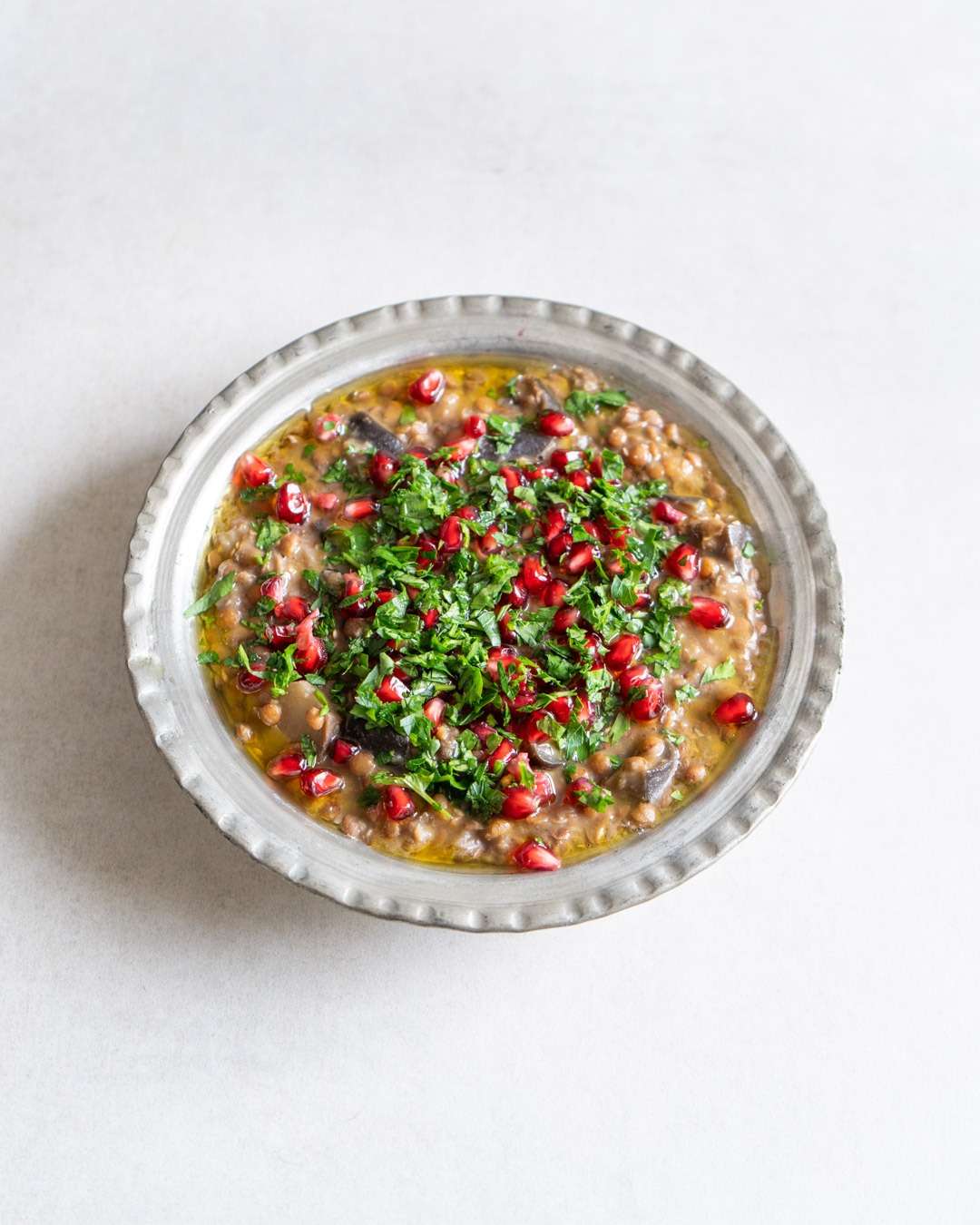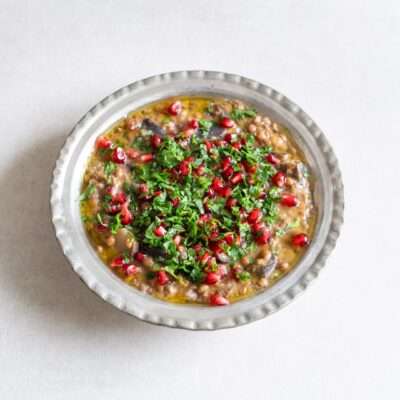Rummaniyeh (Palestinian Aubergine & Lentil Stew)

Rummaniyeh is a Palestinian aubergine and lentil stew that originated in Jaffa. When Palestinians fled historical Palestine, they took their culinary traditions with them, which is why Rummaniyeh is now often associated with Gaza.
The word Rumman translates to pomegranate, the key ingredient that gives the dish its distinctive flavour. Traditionally, sour pomegranates are juiced and added to the dish. Since it can be difficult to source these pomegranates outside of the Middle East, you can also use commonly available pomegranates and add some extra pomegranate molasses or the juice of one lemon.
Besides that, tender brown lentils and aubergines, flavoured with warming spices and thickened with a little tahini, make a comforting stew that is traditionally vegan.
Serves 4
Ingredients
-
1 onion
-
320g brown lentils
-
2 large aubergines (600g)
-
1 tbsp ground cumin
-
1 tsp ground coriander
-
1 tbsp salt
-
300 ml pomegranate juice (from 1 3/4 pomegranates*)
-
Optional: 50 ml pomegranate molasses or juice of 1 lemon
-
1 tbsp bread flour
-
2 tablespoons tahini
-
6 large garlic cloves
-
1 green chilli
-
5 tbsp extra virgin olive oil (for the garlic)
-
30g parsley
-
50g pomegranate seeds (from 1/4 pomegranate)
-
Flatbread bread to serve
Method
Peel and finely chop the onion. Heat some oil in a large saucepan and sauté the onion until translucent. Rinse the lentils under cold water and add them to the pan followed by 900 ml of water. Bring it to a boil, reduce the heat and simmer for 10 minutes until the lentils begin to soften.
In the meantime, cut the aubergines into bite-sized cubes. When the lentils start to soften, stir in the cumin, coriander and salt, then place the aubergine pieces on top, cover the pan and continue simmering for another 20 minutes or until the aubergines are soft.
Whisk together the pomegranate juice (see notes below to make your own) and flour and add it to the pan along with the tahini. Cook for a further 5 minutes to let the flavours combine and the flour thicken the stew. At this point, taste the dish. If it doesn’t have a pleasant tangy flavour from the pomegranate juice, then add the pomegranate molasses or the juice of 1 lemon.
In the meantime, peel the garlic cloves and trim the chilli. Add both to a small food processor and blend until finely chopped. Heat the extra virgin olive oil in a small frying pan and sauté the garlic and chilli until browned and aromatic, then pour it over the lentil stew and gently stir it in. Finally, pick the parsley leaves and roughly chop them.
Divide the stew over four bowls and garnish with the pomegranate seeds, chopped parsley and a drizzle of extra virgin olive oil. Serve with a flatbread of your choice.
*Note: To squeeze the pomegranate juice, start with a large bowl filled with water. Trim the top 1 cm of the pomegranate, thereby revealing where the segments of the fruit are. Now use a knife to make vertical incisions along the segments all around the pomegranate. Gently wiggle each segment to loosen it and pull it out. Then hold one segment at a time under water to avoid the juice from splashing while you remove the seeds. The pith should float to the top. Skim or pour it off and repeat with fresh water if necessary. Then strain the seeds and transfer them to a food processor. Pulse a few times to break down the seeds, then strain them again through a sieve to catch the juice. Use your hands to squeeze the remaining juice out of the pulp.
As an Amazon Associate I receive a small commission from affiliate links on this page.

Rummaniyeh
Ingredients
- 1 onion
- 320 g brown lentils
- 2 large aubergines (600g)
- 1 tbsp ground cumin
- 1 tsp ground coriander
- 1 tbsp salt
- 300 ml pomegranate juice (from 1 3/4 pomegranates*)
- Optional: 50 ml pomegranate molasses or juice of 1 lemon
- 1 tbsp bread flour
- 2 tablespoons tahini
- 6 large garlic cloves
- 1 green chilli
- 5 tbsp extra virgin olive oil (for the garlic)
- 30 g parsley
- 50 g pomegranate seeds (from 1/4 pomegranate)
- Flatbread bread to serve
Instructions
- Peel and finely chop the onion. Heat some oil in a large sauce pan and sauté the onion until translucent. Rinse the lentils under cold water and add them to the pan followed by 900 ml of water. Bring it to a boil, reduce the heat and simmer for 10 minutes until the lentils begin to soften.
- In the meantime, cut the aubergines into bite-sized cubes. When the lentils start to soften, stir in the cumin, coriander and salt, then place the aubergine pieces on top, cover the pan and continue simmering for another 20 minutes or until the aubergines are soft.
- Whisk together the pomegranate juice (see notes below to make your own) and flour and add it to the pan along with the tahini. Cook for a further 5 minutes to let the flavours combine and the flour thicken the stew. At this point, taste the dish. If it doesn’t have a pleasant tangy flavour from the pomegranate juice, then add the pomegranate molasses or the juice of 1 lemon.
- In the meantime, peel the garlic cloves and trim the chilli. Add both to a small food processor and blend until finely chopped. Heat the extra virgin olive oil in a small frying pan and sauté the garlic and chilli until browned and aromatic, then pour it over the lentil stew and gently stir it in. Finally, pick the parsley leaves and roughly chop them.
- Divide the stew over four bowls and garnish with the pomegranate seeds, chopped parsley and a drizzle of extra virgin olive oil. Serve with a flatbread of your choice.

This dish is absolutely delicious! So comforting and nourishing!
I’m so glad to hear that. Couldn’t agree more!
I like to think of myself as a good cook but this is probably the tastiest meal I’ve ever made! Thank you so much for the amazing recipe ????
Amazing! Yeah, it’s packed with flavour, I’m glad you like it!